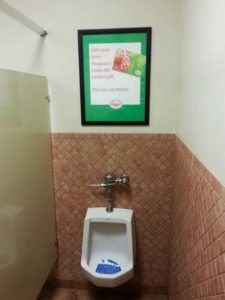Who is your Customer?
Just as important as opening your eyes to the image your business creates is focusing on who your customer is. You can be making great impressions, but if the wrong audience is noticing, it won’t do you much good.
When I owned two retail stores back in the 80s, I could do no wrong. My business kept growing, and my competition was minimal. Back then, you could buy like crazy, load up your stores with a vast variety of inventory, do a fair job with merchandising and customers of all ages and sizes would come flocking in to buy and buy. Those were the days, but times are different now.
As a business grows and changes, so does its customer base. I speak with business owners from across the world, and I am constantly amazed that many cannot articulate who their core customer is. Some have been successful for years, but they are wondering why they are now losing their edge and, even worse, losing customers to the growing competition. These businesses are oblivious to change. They continue to do things the same old way instead of adjusting their marketing efforts to keep up with changes in the industry and, more importantly, the needs of their customers.
A retail store I recently consulted with was throwing lots of money away by advertising in the same newspapers with the same ineffective ads it had been using for years. When we focused on rediscovering its customer base, it was clear why the advertising campaign was no longer working. Over the years, customers had aged and had different needs and concerns. The store redirected its advertising and marketing efforts to target the customer. These new marketing efforts afforded almost immediate results and turned the business in a more focused direction.
Tom Peters, author and management guru, said in Design and Display magazine: “Change is only going to accelerate from here on out.” According to Peters, the issue is not learning new things; it’s forgetting the old ones. High quality alone is not enough to set a company apart in this world of high standards. The company needs to stand out as unique in doing what it does best. Furthermore, Peters points out, with the Internet, we have entered the age of customer control. “Don’t just listen to the consumer and react; lead the consumer,” says Peters.
Gaining Insight into Your Customers
To lead your consumer into the future, you need to first know who they are. To gain insight into your own specific situation and to re-focus on your main customer, ask yourself the following important and revealing questions. For the best results, be brutally honest with yourself.
What is the current state of your customer base? Do you have a strong understanding of your customers? Can you describe them by age, gender, sex, race, income level, needs and concerns? If you can, are you developing your marketing to fit their needs and emotions? Is your existing customer base giving you increasing or decreasing sales? Do you need more customers or do you need customers who spend more money?
Every business has good customers, and every business has customers who you wish you could fire. What is important is to focus on the profile of your best customers and market your business to them. Those good customers may want more quality, higher-end products or different services than you currently offer. Re-evaluate the needs of your best customers and focus all your marketing efforts around those needs.
Who is your competition? Business would be so easy if we had no competition. In fact, I doubt you would be reading this if business were that easy. If you don’t already know who your competition is, start shopping around. Look at the competition from many different angles, not just those places that are directly competitive. Honestly evaluating your competition can teach you many lessons about your own business and where you can improve.
If you know who your competition is, start snooping around to discover what they are doing that is working. They may not have a perfect image or the best service either, but they must be doing something right or they wouldn’t be in business.
Is your competition doing the same things you are? Are you doing them better? Can you do them to benefit your customers even more?
Would you buy a pair of gym shoes in a formal wear store? What business are you really in? Is your business focused, or are you trying to be all things to all people? This is a common mistake among retailers. Many try to carry everything for everyone in fear of losing a customer. This will end up costing you much more in lost sales in the long run. There is no way you can be an expert or niche your business with a large diversity of products. Do what you do well, and let your customer know what you specialize in.
To focus on your key areas, study your sales reports. What areas are the weakest and slowest moving? Figure out what you sell and do best, and leave the rest to someone else. When you pinpoint your expertise, you will naturally excel at that niche; build a stronger customer base; move your merchandise or services quicker; and best of all, increase your profits.
What is your USP? What is your Unique Selling Proposition? In your customers’ eyes, what makes you different from all of the competition? What are you offering that no one else does? Are you just in the inventory business? Or are you in the satisfaction business?
Southwest Airlines is successful not only because it offers the most competitive prices, but also because customers know what to expect. It is a low-priced, reliable airline that delivers their service with fun and uniqueness. So it just hands out peanuts? Who really likes airline food anyway? I fly Southwest because it’s easy, it appreciates my business and it runs on time. Southwest has focused on what is most important to its customers and let go of the rest.
What are your customers thinking? The right side of the brain creates. It is the part of the brain that recognizes trends and visual responses. The left side of the brain is logical; it calculates and stores visual information. It takes those visual details into account and systematically evaluates your image and professionalism. When your image brings the left-brain and the right-brain together, the customer sees your products and/or services as something they need. You have touched all of their senses and responses, so they buy.
When a customer enters your business they instantly start to use the right side of the brain to take in visual stimulation, creating feelings and emotions. They form their own opinion of your establishment and decide whether or not to stay and discover more about your business. This is where your creative and professional business image plays a strong role in keeping the customers’ interest.
They use the left side of the brain to compile the facts they need to understand your products and/or services. With this background, they analyze their personal needs to find a fit. If there is a logical fit and a need will be satisfied, the customer decides to make a purchase.
Are you offering the services and products your customers want? Always keep your customers in mind with every decision you make. Everything you do should satisfy their needs. For example, if they work in the city and commute, stay open late a few nights so they can shop after work. Or open up very early one day a week. Adjust your business to their lifestyle, and try different things to accommodate it.
Are the products or inventory you carry what your customers are looking for, or do they meet your needs and emotions? Are you ahead of the competition, a trendsetter within your industry? Are your customers looking for you to be a trendsetter, or do they want solid, enduring choices? Retail clothing stores often miss out by jumping in at the tail end of a trend instead of taking chances and setting a trend. A customer who is looking for the latest will always perceive them as a follower. On the other hand, some buyers purchase inventory they find exciting and forget about what their customers want. This may seem crazy, but it is sometimes hard to set aside your emotions and focus only on the customers’ needs.
Do your customers need to do business with you? You must grab customer’s attention by cutting through the clutter of their lives with blazing simplicity. It is crucial to concentrate on a core business and a core customer. Á Your image must be the connection between the two. The customer must instantly perceive who you are and what you are about. You will know when you have the right image because it feels right for everything you do. It is truly what your business is all about.
Where are your customers going? Are there some areas of your business that customers avoid? Areas where there is little or no traffic? Study traffic patterns. Does anything impede the customers’ way? Do they have to dodge counters, displays or fixtures?
A detailed study of your business may be a real eye-opener. Take some time to evaluate how your customers are entering and walking around your store. Is the traffic pattern easy to navigate and does it make your customers feel welcome? If not, make the necessary changes and re-evaluate your business again after the traffic patterns have been adjusted.
What makes customers buy? Your marketing campaign helps to build traffic to your business. What you do with that traffic is most important. Just because they come into your business does not guarantee a sale. By focusing on your business from the inside and seeing the details that help a customer make a buying decision you will begin to transform “lookers” into “buyers.” Studies show that customers buy when they are visually stimulated and informed. The product and/or service does not always fit their needs since they buy out of impulse as well. That is why doing your best to convert shoppers through your merchandise; knowledge of the product; and/or service, visual layout and display, and employees is key to making more sales.
Do you need to create a new image? If you are considering repositioning, make a detailed focus plan. You don’t want to risk alienating old customers or confusing new ones. An image change is a leap of faith. Make sure your good customers can make that leap with you.
By answering these questions you have begun to refocus and re-evaluate your customer base and their needs. From your responses you will learn how to adjust and meet the needs of your core customer base. You will discover what makes your business unique and why customers want to do business with you instead of your competition. Then, and only then, will you start to out-market, out-sell and out-profit your competition.


















 Videos
Videos





